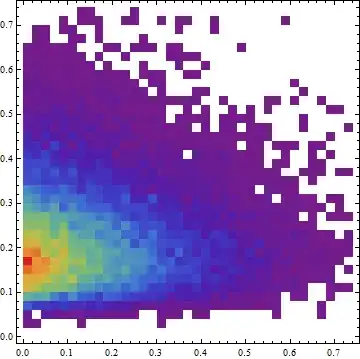I am reading a bit about mixed models but I am unsure over the terms used and quite how they go together. Pinheiro, on pg 62 of his book 'Mixed-effects models in S and S-Plus', describes the likelihood function.
The first term of the second equation is described as the conditional density of $\mathbf{y_i}$, and the second the marginal density of $\mathbf{b_i}$.
I have been trying to generate these log-likelihoods (ll) for simple random effect models, as I thought it would help my understanding, but I must be misinterpreting the derivations.
An example of where I have tried to calculate the ll's.
example model
library(lme4)
model <- lmer(angle ~ temp + (1|replicate), data=cake, REML=FALSE)
conditional log-likelihood
I try to calculate the conditional log-likelihood for this model: it seems from $p(y_i \mid b_i, \beta, \sigma^2)$ that I should be able to calculate this by finding the density of the data at the predictions at the unit/replicate level.
sum(dnorm(cake$angle,
predict(model), # predictions at replicate unit (XB + Zb) level
sd=sigma(model),
log=TRUE))
#[1] -801.6044
# Which seems to agree with
cAIC4::cAIC(model)$loglikelihood
# [1] -801.6044
# or should we really be using a multivariate normal density
# but doesn't make a difference as variance is \sigma^2 I_n
dmvnorm(cake$angle, predict(model), diag(sigma(model)^2,270, 270), log=TRUE)
#[1] -801.6044
marginal log-likelihood
I try to calculate the marginal log-likelihood, which lme4 gives as
logLik(model)
#'log Lik.' -834.1132 (df=4)
Taking a similar approach as before it seems from $p(y_i \mid \beta, \theta, \sigma^2)$ that I should be able to calculate this by finding the density of the data at the predictions at the population level, but it is not close.
sum(dnorm(cake$angle,
predict(model, re.form=NA), # predictions at population (XB) level
sd=sigma(model),
log=TRUE))
# [1] -1019.202
So perhaps I need to use the second equation and need to use the conditional model for y and the marginal for b, but still not close.
sum(
dnorm(cake$angle, predict(model), sd=sigma(model), log=TRUE) , # conditional
dnorm(0, ranef(model)$replicate[[1]], # RE predictions
sd=sqrt(VarCorr(model)$replicate), log=TRUE)
)
# [1] -849.6086
Edit: Next go...
For the linear mixed model $Y = X\beta + Zb + \epsilon$, $b_i \sim N(0, \psi)$ and $e_i \sim N(0, \Sigma)$ I thought perhaps the variance for the likelihood calculation should be estimated as var(Y) = $Z\psi Z^T + \Sigma$, but wrong again!
So in code
z = getME(model, "Z")
zt = getME(model, "Zt")
psi = bdiag(replicate(15, VarCorr(model)$replicate, simplify=FALSE))
betw = z%*%psi%*%zt
err = Diagonal(270, sigma(model)^2)
v = betw + err
sum(dnorm(cake$angle,
predict(model, re.form=NA),
sd=sqrt(diag(v)),
log=TRUE))
# [1] -935.652
My question:
- Can you tell me where I went wrong in calculating the marginal likelihood. I am not really needing code to reproduce the ll but more a description of why the approach I tried does not work.
Many thanks.
PS. I did look at the function that generates these values, lme4:::logLik.merMod and lme4:::devCrit and see the authors use some difficult / technical approach, which again leads to me needing help why my approach is wrong.
